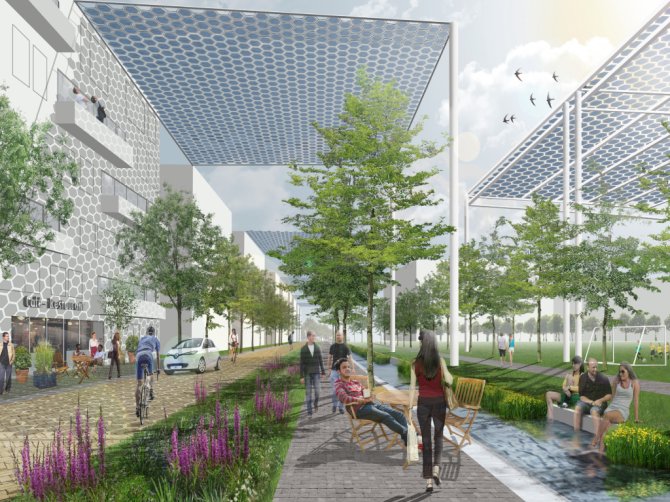
News
2nd round for Tom van Heeswijk and his team
Out of 250 submissions from people in over 40 countries Tom’s project was awarded one of the ten finalists, that presented their imaginative ideas on March, 16th at Kytopia in Utrecht.
In a post-fossil city public spaces are more than places to live, work and recreate. In a post-fossil city public spaces are places that generate sustainable solar energy, that is used in households, electric cars and other amenities. – ‘Solar energy in public spaces’ is the answer of former WUR Landscape Architecture Student Tom Heeswijk and his team to the contest ‘Post Fossil City’ hosted by Prof. Maarten Hajer, the Urban Futures Studio at Utrecht University. The contest called on artists, designers, architects and other creative thinkers to imagine a city that is not addicted to fossil fuels. How would that change the way urban residents live, work and move around in cities? Out of 250 submissions from people in over 40 countries Tom’s project was awarded one of the ten finalists, that presented their imaginative ideas on March, 16th at Kytopia in Utrecht.
The project ‘Solar energy in public spaces’ rethinks the spatial layout and functionality of dense urban areas to make cities independent from fossil fuels. It is built upon Tom’s MSc thesis ‘Shaping solar energy for an energy neutral Zeeburgereiland in Amsterdam’ supervised by Sven Stremke and Rudi van Etteger. The idea is informed by perception research on renewable energy, since people’s experience of their living environment is fundamental for their quality of life in cities. Evidence showed that when renewable energy carries visual appeal while contributing significantly to energy demand, the post-fossil city might be not far away. Organic Photo Voltaic (PV) covers or PV cells in glass are existing technologies offering numerous possibilities for design. The idea of OPV as a cover -or pergola- in public space is flexible in applicability and can attractively be integrated in multiple scale situations, such as a restaurant’s terrace, street canyons, sports field, large parking lot or highways. The transition area Binckhorst in The Hague is the first case that showed interest in developing OPV pilots within public spaces. ‘Solar energy in public spaces’ imagines the post-fossil city harvesting the sun, just like plants have been doing through photosynthesis for millions of years.
With a support of €1,000 and from the Urban Futures Studio’s Tom and his team will work out their plans in a second round. Until June they are encouraged to develop their ideas further towards realization. They are looking for additional sites and OPV product developers to realize, test and advance the idea in urban living labs. Interested partners can contact Tom van Heeswijk (tom.vanheeswijk@gmail.com) or Wiebke Klemm (wiebke.klemm@wur.nl). The finalized work will be displayed at the Post-Fossil City Exhibition in Utrecht, on June 15th. During the opening event, the winner will be announced to receive € 10,000 for the best Post Fossil City project.
